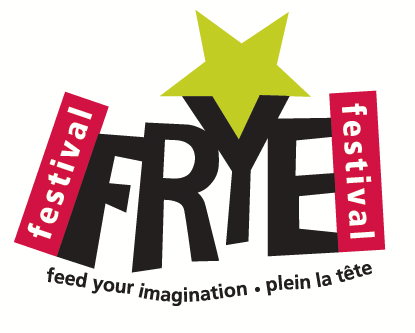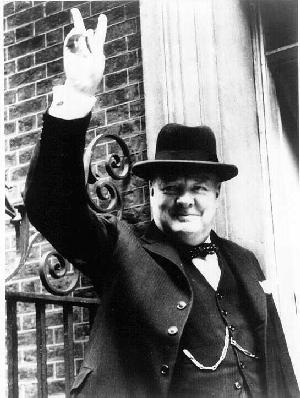January’s Frye Festival Newsletter is posted here.
Monthly Archives: January 2010
Shakespeare, Frye & Ideology
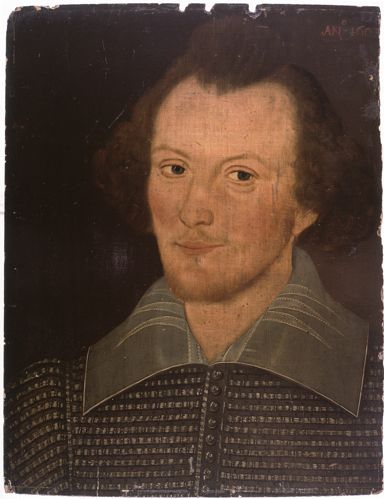
The “Sanders portrait,” the “Canadian” Shakespeare unveiled in 2001, purportedly painted from life in 1603.
Russell’s post on Greene and Shakespeare raises a number of questions about the relation between literature and ideology — a subject that has always been at the centre of literary criticism and shows no sign of going away.
Frye, in a display of irreverence as cheeky as Greene’s, famously observed (referring both to the relatively thin biography and the posthumously published Droeshout portrait) that we have very little hard data about Shakespeare: a few signatures, a handful of addresses, “and the portrait of a man who is clearly an idiot.” As Russell points out, Frye is always able to make a distinction between the “man” (who may possess idiotic personal qualities and even more idiotic ideological views) and the “writer.” For current critical theory and practice, this must seem an indefensible position. How is it possible for anyone to produce work independent of their all-encompassing social conditioning and the prejudices it spawns?
For Frye, the answer begins with the fact that literature possesses both “autonomy” and an “authority” unique to it. Literary archetypes — whose universality can be discerned by the widest possible inductive survey of literature throughout history and across cultures — are expressive of imaginative constants and primary existential concerns. Moreover, the context is fundamentally different. Language in its everyday social function is “work”: expressing beliefs, necessities, truths, and so on. Literary structures, on the other hand, are, in their imaginatively recreational function, “play”: they “exist for their own sake” and provide no requirement of belief or claim to truth. Ideology, in short, compels; literature invites. And upon that distinction everything follows, including the fact that the writer (like, say, T.S. Eliot, about whom Frye directly addresses this very issue) may be consciously pushing a personal ideological agenda from which the literature itself displays a stubbornly independent purpose. This is why literature is potentially “visionary”: it provides us with a clarified sense of what we want and who we would like to be without providing any compulsory program of action or belief. Literature as recreation merely provides the opportunity for re-creation; it does not and cannot compel it. What we choose to do in response to the existentially concerned but still aesthetic experience of literature is always entirely up to us, including (as we know all too well) doing absolutely nothing at all.
Frye more or less takes up these issues in the opening pages of the Introduction to On Shakespeare. In fact, here is the complete second paragraph of that Introduction:
We have to keep the historical Shakespeare always present in our minds to prevent us from trying to kidnap him into our own cultural orbit, which is different from but quite as narrow as that of Shakespeare’s first audiences. For instance, we get obsessed by the notion of using words to manipulate people and events, of the importance of saying things. If we were Shakespeare, we may feel, we wouldn’t write an anti-Semitic play like The Merchant of Venice, or a sexist play like The Taming of the Shrew, or a knockabout farce like The Merry Wives of Windsor, or a brutal melodrama like Titus Andronicus. That is, we’d have used the drama for higher and nobler purposes. One of the first points to get clear about Shakespeare is that he didn’t use the drama for anything: he entered into its conditions as they were then, and accepted them totally. That fact has everything to do with his rank as a poet now. (On Shakespeare, 1-2)
So what does Shakespeare’s “rank as a poet” really amount to? It may be summed up by the fact that he does not ever subordinate the autonomy and authority of his art to any external consideration: “all the world’s a stage” is not just a clever conceit in Shakespeare, it is a radical metaphor of his imaginative worldview. As Frye puts it, “In every play Shakespeare wrote, the hero or central character is the theatre itself” (OS 4). He may reflect the beliefs, biases, anxieties and prejudices of his time in a way his audience might recognize and even approve of, but he doesn’t promote them. The Merchant of Venice is nowhere close to reducible to the anti-Semitism it conjures; The Taming of the Shrew overturns the complacent sexism it renders; The Merry Wives of Windsor unexpectedly offers up a more egalitarian and tolerant vision of society once the knockabout farce has played itself out; and Titus Andronicus proves to be a powerful meditation upon the grisly absurdity of the human capacity for cruelty. Why? Because Shakespeare allows his plays to play without ever feeling the necessity of putting them to work in the name of some ideology, however noble or well-intentioned it may otherwise claim to be.
Quote of the Day
Michael Dolzani: Necessary Angels
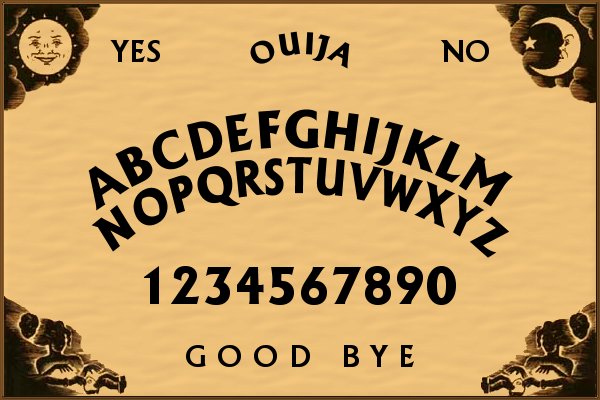
I remember Imre Saluszinsky writing to me years ago, when the Late Notebooks were first published, saying how astonished he was when he read passages from Notebook 44 such as the following, in which Frye is reacting to Helen’s death: “When Helen died, the real Helen became an angel in heaven….Helen was a pile of ashes, an absence to me, and an angel: perhaps she’s a genius to me (or anyone else who loved her and is still living or not living and still confused)” (CW5: 254). Could Frye really mean that he thought Helen could be an angel? Frye is a liberal intellectual, and for liberal intellectuals such metaphors as “eternal life” are merely figures of speech, not realities. Surely eternal life really means to survive in the memories of friends, or to be “one with nature” by becoming part of the nitrogen cycle. But if Frye was opposed to demythologizing the Bible, he would also have been opposed to demetaphorizing it. (I promise to use that hideous word only once). This makes us uncomfortable: it seems to move Frye closer to the kind of fundamentalist literalizers that he himself so often satirized. So we are perhaps most comfortable thinking of the quoted passage “merely” as an irrational outburst of unbearable grief. After all, the idea is not even Christian: dead human beings do not become angels in Christian heaven.
However, this entry is the final one in Notebook 44; it occurs 117 pages after the announcement that Helen has died. A mere 11 pages after that announcement, Frye is in a state of mind that most of us could understand more readily; moreover, in this earlier passage, he links Helen’s death to the passage from Hebrews that people have been discussing lately: “I’ve said that I have hope about another life, but I don’t have faith, in the Hebrews sense of a hypostasis of hope. The furthest I can get is a negative faith: I do not believe that those ten squalid and humiliating days in the Cairns hospital is the total end of a lovely and lovable human being. (Total for all practical purposes: Butler & others would talk about surviving in the memory of others, but miserable comforters are they all. She’s in heaven, Catherine said: but I don’t know where (or what) heaven is, or whether the word ‘where’ applies to it” (CW5: 148).
Yet Frye gradually develops that negative faith in the direction of a positive faith in Helen’s continued presence, in passages such as the following: “But grief emphasizes the pastness of the past, and so works against the mythical imagination. Helen was—that’s the beginning of tears and mourning. Helen is. What she is, perhaps, is a central element in the unseen which will clarify my understanding, if such clarification is granted to me” (CW5: 139). Here, the hope for eternal life has been provided with substance and evidence: Helen is not absent, but present, here and now. However, I think faith has two aspects, present and future. It provides an experience of infinity and eternity here and now, the world in the grain of sand, eternity in an hour. But the alternative translation of hypostasis as “assurance” for the future may be an aspect of faith as well. This is the theme of Milton’s Nativity Ode: that on the morning of Christ’s nativity, our redemption is accomplished now—but not yet. In Frye’s case, Helen is present now, but that presence provides hope for a future in which they will be reunited in eternity. Only a saint could maintain such faith continuously, but the memory of such moments helps to sustain us in the dark times, when “we find ourselves staring blankly into an unresponding emptiness, utterly frustrated by its indifference,” as Frye puts it in “To Come to Light,” a sermon of 1988.
Frye’s sense of Helen’s presence as a guardian spirit and Beatrice figure apparently remained on the level of intuition and not of direct vision. He was, after all, an intellectual. But in others, extremity has at times produced actual visions, such as Blake had after his brother Robert died. An unexpected publishing phenomenon of the last couple of months has been that of Jung’s Red Book, in which he recorded and illustrated a series of visions he had over a period of several years, midway in the journey of his life, when he had been cast out of the Freudian movement and found himself in a dark wood. Intellectuals, liberal and otherwise, have always been convinced that Jung was a nut case, and one awaits the inevitable reviews of the Red Book proclaiming that their hunches have been confirmed. But the funny thing is, all sorts of people have become fascinated enough with the volume to pay $195 dollars for it. Perhaps I should not be so impatient with such intellectuals, but they seem totally unaware of how they—like most people, to be sure—have carefully arranged their lives so that nothing visionary or uncanny could ever enter into them. This provides circular proof for them that the visionary and uncanny do not exist, except as pathological delusions.
Shakespeare the Establishment Conformist, or The Virtue of Disloyalty: Northrop Frye and Graham Greene (3)

The “Cobbe portrait,” allegedly a newly-identified image of Shakespeare fully decked out in establishment conformist finery
In an earlier post, I compared Northrop Frye’s and Graham Greene’s readings of Henry James. Greene’s criticism often seems eccentric, a product of the same obsessions that drive his fiction. His discussion of Shakespeare is as distinctive as his essays on James. In 1969, Greene received the Hamburg Shakespeare Prize, endowed by an Anglophile German, and awarded to British citizens for artistic achievement. He marked the occasion with an address entitled “The Virtue of Disloyalty” which begins,
Surely if there is one supreme poet of conservatism, of what we now call the Establishment, it is Shakespeare. . . . If there is one word which chimes through Shakespeare’s early plays it is the word “peace.” In times of political trouble the Establishment always appeals to this ideal of peace. . . . Peace as a nostalgia for a lost past: peace which Shakespeare associated like a retired colonial governor with firm administration.
In what follows, two of Greene’s major obsessions, Roman Catholicism and betrayal, coalesce in a discussion which, however inadequate as Shakespeare criticism, reveals much about Greene’s view of the writer’s role in society. One should bear in mind that the speech was given during the Cold War, at a time when Russian dissident writers were much in the minds of people in the west, and that it was given to a German audience, about twenty-five years after the end of the second world war.
Greene is deliberately provocative in the sardonic manner in which he discusses the great national poet after whom the prize was named. “There are moments,” he says, “when we revolt against this bourgeois poet on his way to the house at Stratford and his coat of arms, and we sometimes tire even of the great tragedies, where the marvellous beauty of the verse takes away the sting and the last lines heal all, with right supremacy re-established by Fortinbras, Malcolm and Octavius Caesar.” Greene then continues:
Of course he is the greatest of poets, but we who live in times just as troubled as his, times full of the deaths of tyrants, a time of secret agents, assassinations and plots and torture chambers, sometimes feel ourselves more at home with the sulphurous anger of Dante, the self-disgust of Baudelaire and the blasphemies of Villon, poets who dared to reveal themselves whatever the danger, and the danger was very real.
Shakespeare does not, for Greene, belong in the company of Russians such as Pasternak and Solzhenitsyn, though, anticipating recent postcolonial critics, he detects a note of rebellious outrage in Caliban’s speech “You taught me language; and my profit on’t / Is, I know how to curse.”
Greene then goes on to contrast Shakespeare, “the great poet of the Establishment,” with the brilliant but minor poet and Jesuit martyr Robert Southwell. If only Shakespeare had shared Southwell’s disloyalty, Greene says, “we could have loved him better as a man.” The remainder of the short essay argues that the writer should be opposed to the State, acting as a devil’s advocate in the face of official efforts at scapegoating. The writer should always be counter-cultural, “a Protestant in a Catholic society, a Catholic in a Protestant one.” The writer should be ready to change sides at a moment’s notice, for “He stands for the victims, and the victims change.” This does not mean that the writer is a propagandist, but rather someone who enlarges the bounds of sympathy, “making the work of the State a degree more difficult.” Greene concludes, perhaps to the discomfort of some in his audience – apparently the lecture was received enthusiastically by the students who were present – by presenting, as his final example of the virtue of disloyalty the German theologian Dietrich Bonhoeffer, who “chose to be hanged like our English poet Southwell. He is a greater hero for the writer than Shakespeare.”
Art
httpv://www.youtube.com/watch?v=Cri7aQHRT7k
This video shows the winner of “Ukraine’s Got Talent,” Kseniya Simonova, 24, drawing a series of pictures on an illuminated sand table showing how ordinary people were affected by the German invasion during World War II.
She begins by creating a scene showing a couple, sitting holding hands on a bench under a starry sky, but then warplanes appear, and the happy scene is obliterated.
It is replaced by a woman’s face crying, but then a baby arrives, and the woman smiles again. Once again, war returns, and Miss Simonova throws the sand into chaos from which a young woman’s face appears.
She quickly becomes an old widow, her face wrinkled and sad, before the image turns into a monument to an Unknown Soldier.
This outdoor scene becomes framed by a window as if the viewer is looking out on the monument from within a house.
In the final scene, a mother and child appear inside, and a man standing outside, with his hands pressed against the glass, saying goodbye.
Mesmerizing!
The Great Patriotic War, as it is called in Ukraine, resulted in one in four of the population’s being killed, with eight to 11 million deaths out of a population of 42 million.
Kseniya Simonova says: “I find it difficult enough to create art using paper and pencils or paintbrushes, but using sand and fingers is beyond me. The art, especially when the war is used as the subject matter, even brings some audience members to tears. And, there’s surely no bigger compliment.”
Virginity in Book I of “The Faerie Queene”
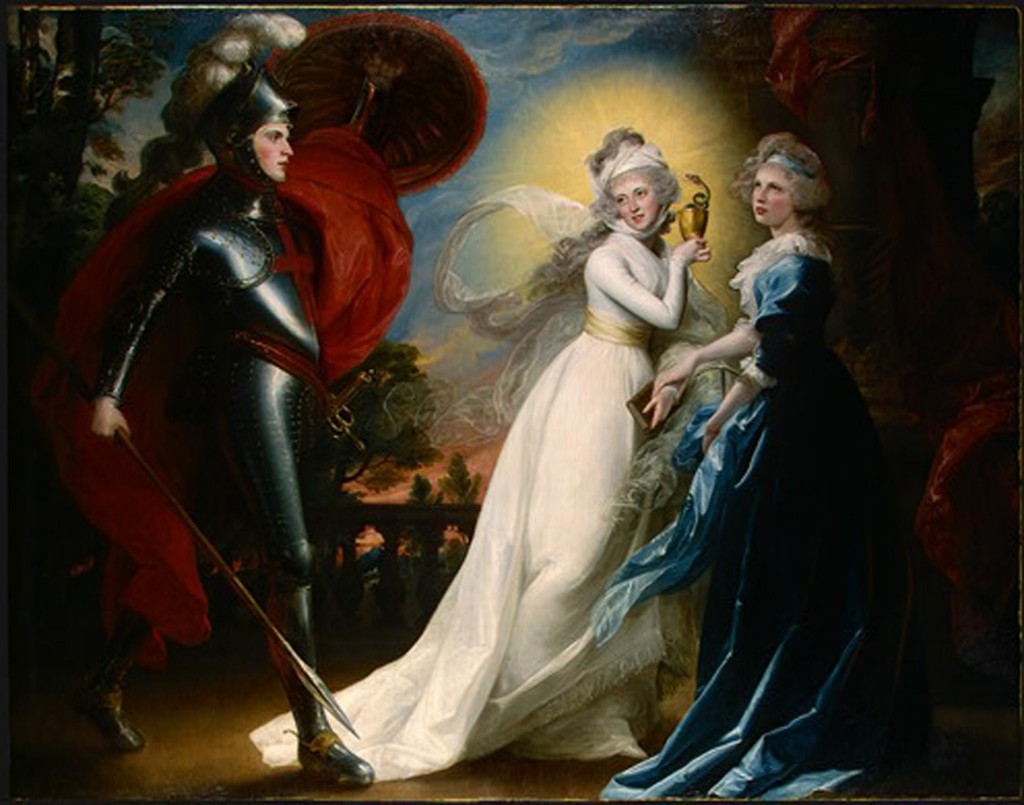
John Singleton Copely, The Red Cross Knight, 1793
With this post, Trevor Losh-Johnson joins us as a byline correspondent.
My orientation to romance is by way of The Faerie Queene, where many of the motifs of romance occur in a more condensed form. And, since Spenser crops up again and again in Frye, it might be worth posting some thoughts regarding the role of virginity in that poem, especially in its first book, which deals with the quest of the Redcrosse Knight.
As she is literally as pure as the driven snow, it is easy to take Una as a prototypical romantic virgin. In the third essay of Anatomy, Frye notes that Una’s parents, “are Adam and Eve; their kingdom is Eden or the unfallen world, and the dragon, who is the entire fallen world, is identified with the leviathan… Thus St. George’s mission, a repetition of that of Christ, is by killing the dragon to raise Eden in the wilderness and restore England to the status of Eden.” (194). Una’s black wimple, a hymen of sorts, is worn also as a mark of mourning for her parent’s fallen kingdom, and her marriage to Redcrosse (St. George) can only occur once her kingdom is restored. Indeed, once Redcrosse delivers the kingdom, her veil is lifted to reveal her face, and that deliverance is perhaps a public expression of the perennially deferred, private consummation with Redcrosse.
The doubling of heroines Joe speaks of occurs here in the context of demonic parody. Duessa, who is allegorically the Whore of Babylon, parodies Una, who is allegorically the one true faith. An essential function of Duessa is that she briefly tempts and enthralls Redcrosse from this ultimate consummation. As for the role of gender, virginity is expected of Redcrosse in the context of fidelity. The purgatorial House of Holiness is attended by, among many virtues, Fidelia and Speranza, who are also virgins. Their mother is, however, Caelia, who to “a louely fere/ Was lincked, and by him had many pledges dere.” There may be a buried analogy between the virgin Fidelity in her married mother’s House of Holiness and the virgin Una who shall be married and inherit the regenerated society of her parents.
In the third book, the virtue of Chastity is also framed in the context of fidelity, and it is expected that there will be lots of sex when Britomart finally unites with Artegall. It is noteworthy that Britomart is to embody the virtue of Chastity, and not the flat virginity that Una embodies until her kingdom is released. But this may have its basis less in the manifold politics of gender than in the structure of the allegorical romance. Generally, as far as I can dimly see, the characters and stations that populate the quest are objectified projections of the central figure. In this solipsistic world, Redcrosse is anatomized by the other characters, and Una’s virginity may be a static expression of his own chastity. To whatever extent this can be said, I think that the progress of the first book’s quest may be read as an alignment between the progress from the fallen world to Eden and the progress from a hostile virginity to sexual chastity. It also parallels the process of condensation from the literature of doppelganger heroines to the chastity of Adam and Eve that Frye explores in Words With Power.
As convoluted as this may sound, there seems to be in romance a connection between the upwards movement from virginity to chastity and Frye’s discussion of the Eden metaphor, to wit, “What is significant is the way in which poets preserve and emphasize the metaphorical identity of the bride’s body and the garden, which enables them to associate sexual emotion with visions of a renewed nature.” (198).
Michael Dolzani: Spiritual Otherness (2)
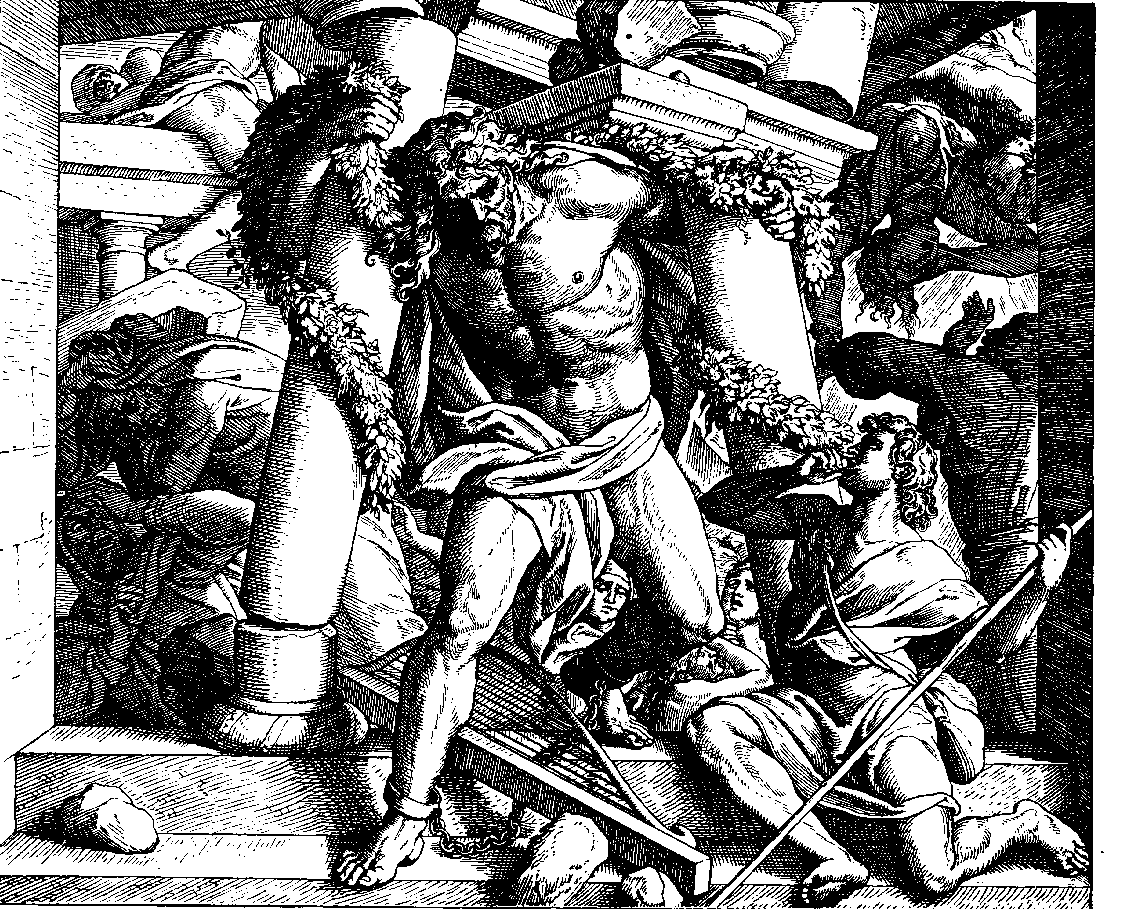
Von Carolsfeld, Samson Destroys the Temple, 1880
Responding to Matthew Griffin and Clayton Chrusch, regarding my earlier post.
Matthew, I am moved by the warmth and generosity of your response. I’m very glad what I wrote was useful to you, all the more because there is a reciprocity: your response was what chiefly inspired a follow-up posting of mine that I’ll be sending along as soon as I’m sure it’s entirely coherent. The Hebrews passage is indeed a key, and I thank you for reminding me of it. Epiphany is a perfect time to be discussing these things–I hadn’t even thought about that!
Second, to Clayton Chrusch: Wow. I admire the marriage of articulate intellect and emotional intensity in this response. Literary criticism could use more of this directness. You raise issues so immense that I know I haven’t thought through them completely yet, but you deserve at least something of an immediate response. Concerning God, yes, as Jesus he is an object, a historical personage–and therefore bound up with all the ambiguities of our relationship to objects, starting with the fact that there is no historical evidence that he even existed. The quest for the historical Jesus leaves us more distanced from God than ever. God could also be considered as a subject, but not as what we usually mean by a subject, namely, the ego of the natural man. Jung’s Self/ego distinction is helpful here, and the Jungian Self is in fact a God-image. If God is a person, it is not the same sense in which I am a person. For example, he is not limited by time and space, those conditions which define ego-consciousness. When Paul says, “I, yet not I, but Christ in me,” he is speaking of the person of Christ as dwelling within him, an interpenetration that the ego or natural man is not capable of. I’m sure you know all this; I’m just struggling to clarify my vocabulary.
I absolutely agree with you that “real” and “true” are words that may be applied to the imagination; otherwise, the imagination’s products are just beautiful illusions, and that gets us nowhere. I was just trying to make the distinction that “real” and “true” here must mean something other than “objectively factual.” A scientist or historian means something else by these terms. That’s why the reality and truth of the spiritual world cannot be proved by scientific or historical methods.
As for suffering, I don’t think you misspoke–in fact, that was probably the part of your response that I admired the most. I see why you qualify the response, though: yes, there are things more important than avoiding pain. Though I’m sure you’d agree that we have to be careful to state this precisely, because what we’re really talking about here is martyrdom. For the Tibetan monks, or the early Christian martyrs, this meant accepting their own suffering for the sake of something more important. But when I teach Milton’s Samson Agonistes, I ask students the troubling question: what makes Samson different from a suicide bomber? Samson too experiences “a renovation of the will so complete and so secure that it doesn’t matter any longer what place” he is in (marvelous passage, by the way). But he also finds acceptable the suffering of the Philistines who will die along with him when he pulls down the Temple, just as the suicide bombers felt when they brought down our Temple, the World Trade Center. Anyway, thank you for a searching and stimulating response.
The Doubled Heroine Device, or Betty and Veronica

In response to the “virginity” thread started by Jonathan Allan’s post, I think it wrong to suggest that Frye himself has gendered virginity: he is simply describing what he finds in literature, and he is obviously well aware of the value put on virginity as a commodity in a patriarchal culture, as his allusion to the danger of losing one’s bargaining position indicates. In romance this aspect of virginity is naturally enough prominent because the female protagonist is headed for marriage and must keep herself intact for Mr Right. As Frye says, the G-string comes off last. This can mean not just outwitting pirates and other villains but also keeping her true love, when he acts like a pirate himself (as in Pamela and Jane Eyre), from treating her as a slave or social inferior and trying to take her virginity before he has married her. But this is precisely what makes virginity a structural principle in romance, as the heroine uses her wiles to escape, survive, and attain sexual union with the right man at the end of the story. This is all of course discussed in The Secular Scripture.
Where virginity comes to take on another dimension is the point of the epigraph from Frye that Bob used in his post: “virgnity means a transcending of sex.” Jonathan Allen commented in this regard on the device of the two heroines, quoting the pertinent passage from The Secular Scripture: “the virgin who marries at the end of the story, we saw, represents the structural principle of the cycle and accommodation of it. The virgin who is sacrificed, or escapes sacrifice and remains a virgin, similarly symbolizes the other principle, the separation or polarizing of action into two worlds, one desirable and the other detestable” (83; CW XVIII: 56).
The two heroines can also represent what Frye calls the two cadences or “creative moods” of romance, the comic and the tragic or romantic, the social and the withdrawn, the world of ritual and the world of dream. The device is, in general terms, part of the general structure of doubling in descent narratives, a milder form of the doubling that you get in a tale like Poe’s William Wilson. An important prototype is Milton’s two muses in L’Allegro and Il Penseroso, the one sociable and light-hearted, the other withdrawn and pensive.
Scott used the device in several of his novels and brought it into into popular use in the nineteenth century where it is all but ubiquitous, at least in the Anglo-American tradition; it does not seem, as far as I can tell, to have the same prevalence on the Continent. Stendhal–an early and avid reader of Scott–uses a version of the device in his two great novels, The Red and the Black and The Charterhouse of Parma: Julien Sorel is torn between the withdrawn and pensive Louise de Renal and the more political and theatrical Mathilde de la Mole; Fabrice del Dongo is torn between his socially adept and politically astute aunt, Gina Sanseverina, and the withdrawn and melancholic Clelia Conti.
The device is now known in my classes, thanks to a student wit, as the Betty-and-Veronica device. By the way, I was told by the same young woman that the problem of the two heroines is beautifully solved in the Archie comics: in a recent issue of the comic book Archie marries both of them, thanks to the possible futures of Borges’s garden of forking paths.
A romance device, the doubled heroine is a central structural principle in realist novels as well: George Eliot uses it in a number of her novels: Lucy Deane and Maggie Tulliver in The Mill on the Floss (where the device itself is a meta-fictional theme in the novel: Maggie says she cannot finish novels in which the “dark unhappy ones” are doomed from the beginning); Dorothea Brooke and Rosamund Vincy in Middlemarch; and Gwendolyn Harleth and Mirah Cohen in Daniel Deronda. The latter breaks with the tradition, which goes back to Scott and the two heroines of Ivanhoe, by having the hero marry the dark Jewish heroine, the Rebecca figure, and reject the Rowena figure, Gwendolyn. As Russell Perkin noted in a previous post, there is a good example of it in Mad Men: Don Draper is torn between his uptight conventional blond wife, Betty, and the dark and alluring Jewish businesswomen, Rachel Menken.
There are of course male versions of the same thing (Wuthering Heights and Gone with The Wind being obvious examples), and Frye even gives an example of an unhappy male virgin who is sacrificed: “the martyrdom of Sydney Carton at the end of A Tale of Two Cities.”
The device, which is first briefly discussed in Anatomy, is one of those conventions that Frye draws attention to as part of a much larger argument, but which is really worth a book-long study in its own right. I wonder, Jonathan, if your “virginity” project might not be turned more fruitfully in the direction of the doubled heroine convention itself.
Religious Knowledge, Lecture 15
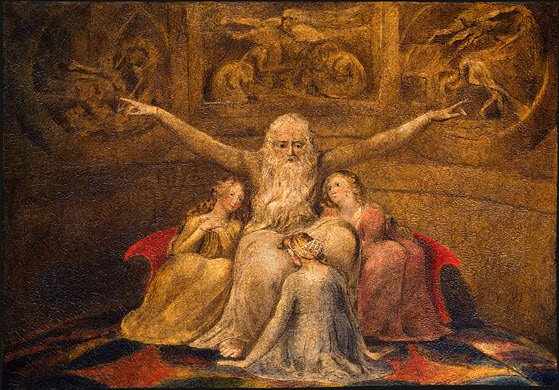
Blake's Job and His Daughters, 1800
Lecture 15. January 27, 1948
THE BOOK OF JOB
The whole meaning of this book is complicated. It is completely a work of literary art, and affords the guarantee that, for the Bible, the use of the poetic imagination is legitimate and essential. It is akin to literary forms we meet elsewhere. The original of epics and sagas are all there in the Bible, but they have been incorporated into something else. Only the forms that are on the more remote side, such as letters, memoirs, have continued as definite forms.
Job seems unconnected with anything else in the Bible, except in tone. It was probably subject to an editing process. But the editing, as well as the writing, is inspired. It is a fairly late book.
Shakespeare’s comedies start out as light, urbane, sophisticated romance, like Twelfth Night, which has a lilt to it, and we enter into a carnival world where frustrations have disappeared. The later comedies have elements which disrupt the feeling of pleasantness. The Merchant of Venice is practically a tragedy. Shylock disturbs us, and the metallic quality of the imagery effects the whole tone. Then his comedy digs more deeply into the tragedy of life. The sense of escape, of the fairy world, fades out. All’s Well That Ends Well has an ironic title. Falstaff is an ambiguous character; he is not a figure of fun; the tragic and the comic are rooted in him. The Winter’s Tale and The Tempest have serenity and repose.
Job is a tough piece of work. The last chapter has the feeling of comic resolution—he has got everything back. Yet it isn’t resolution. If you lose something, you don’t get it back. The notion that Job could be restored doesn’t work.
WHY DO THE INNOCENT SUFFER?
The heart of the book is a discussion as why the innocent suffer. The three comforters are not fools; they are trying to help, to bring balance and reason into his mind through Jewish law. They are people of human sympathy, conventional people as in Greek tragic chorus, the voice of common sense. Job doesn’t make a much better show than they do. The sense that Job is a tragedy is because of the dialogue concerning the suffering of the innocent, which is the theme of all tragedy.
It is tormenting to anyone but the reader who has read the prologue. We cannot forget that “way up in the gods” are God and Satan betting on Job. The one argument that newer occurs to the comforters is that God wants to settle a bet. They assume that Job is suffering because he has done wrong. We know it is because he has done right. Job is happy and prosperous because he is attached to God. Man fell because he detached himself from God. Here, God withdraws from Man, a paradox.
Job and his friends take part in a dialogue. The author is trying to fish something out of tragedy, to establish the point of tragedy. The point of Job is “why do the innocent suffer?” This is the same question as in Lear in Cordelia’s death. The tragic flaw as a moral judgment is not a tragic flaw at all. In Milton, the flaw in Adam is that he is a creature of free will. But Adam’s flaw does not infer a moral judgment on God.
Job says, I have done nothing to deserve this. The flaw is that he exists. The flaw, therefore, seems to be in the God that made him. Yet, a moral judgment on God is irrelevant.
